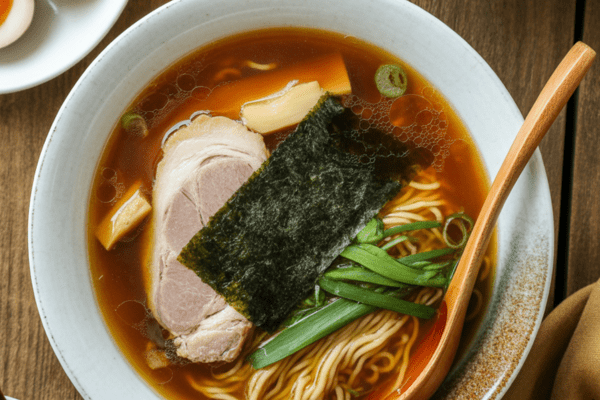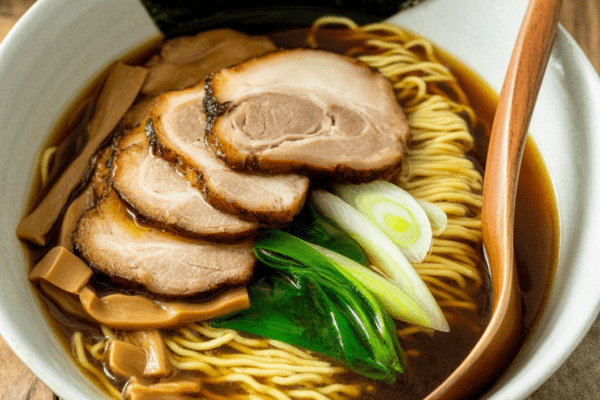If there’s one dish that makes me feel like I’ve been transported straight to a tiny ramen shop in Tokyo, it’s Shoyu Ramen. There’s something so deeply comforting about the clear, soy sauce-based broth, springy noodles, and meltingly tender slices of chashu pork. This is a project, no doubt—a true labor of love—but it’s the kind of slow, intentional cooking that feels so rewarding, especially when you serve up steaming bowls to friends or family.

I want to share not just the steps but also the real-life tips and details that make this recipe special, so you can recreate that ramen-shop magic in your own kitchen.
Why You’ll Love This Recipe
What makes this shoyu ramen so special? It’s all about layers of flavor that come from patience and good ingredients. The broth simmers away for hours, developing an incredible depth that you just can’t get from shortcuts.
When I first tackled homemade ramen, I was intimidated by the time commitment, but it turned out to be incredibly forgiving. Most of the work is hands-off, letting you potter around the kitchen or read a book while the house fills with the most amazing aroma.
I also love that it’s flexible. You can prepare the components in advance and freeze them for easy ramen nights down the line. There’s something deeply satisfying about pulling homemade broth and chashu out of the freezer and knowing dinner will be spectacular.
Ingredients
Here’s what you’ll need to make this cozy, classic bowl.
For the Broth:
- Pork leg bones (femur and knuckle are best for sweet, rich broth)
- Aromatics like onion, garlic, ginger, and green onions
- Rendered chicken fat (adds silkiness and flavor you shouldn’t skip)
For the Chashu:
- Long strips of pork belly (skin removed)
- Soy sauce, sake, mirin, salt (this simmered sauce becomes the tare for the broth too)
For the Ramen Bowl:
- Fresh ramen noodles (ideally wavy, medium-thin)
- Green onions, nori sheets, seasoned bamboo shoots (menma) for topping
- The reserved shoyu tare (the salty, umami-rich seasoning for the broth)
Substitutions:
- If pork leg bones aren’t available, neck or spine bones work too.
- Pork shoulder can stand in for pork belly, though the texture will be different.
- For aromatics, green onions or scallions work if you can’t find Tokyo negi.
When I make this, I source pork belly and bones at my local Asian market, and I love browsing for extra toppings to make each bowl feel special.
Tips and Tricks
This is the kind of recipe where a little know-how goes a long way:
1. Read Ahead:
I always read the entire recipe twice before starting. Once when making the shopping list, and again before cooking so I don’t forget anything.
2. Use the Right Pot:
You really do want a big 12-quart stockpot for simmering the bones. If you try with a regular large pot, you’ll have to keep topping up with water, which dilutes the flavor.
3. Skim the Broth:
Keep your broth clear and beautiful by skimming off any foam or scum. I get a little obsessive about this step, but it’s worth it.
4. Tying the Pork Belly:
Tie it snugly with butcher twine before simmering. This keeps the shape nice and makes slicing easier later.
5. Chill the Chashu:
After braising, chill the chashu thoroughly before slicing. The fat firms up, so you get perfect, even slices that hold together in the bowl.
6. Adjust the Tare Carefully:
The tare (seasoned sauce) is salty on its own. When serving, start with about a tablespoon per bowl and adjust to taste.

Make Ahead Tips
The beauty of this recipe is that it actually suits meal prep really well.
- Make the broth and chashu in advance. They both freeze wonderfully. I like freezing the broth in individual portions for easy thawing.
- Chill the chashu and slice it once cold. You can freeze the slices in layers separated by parchment.
- The tare lasts in the fridge for weeks.
Whenever you want ramen, just cook the noodles, warm the broth, and assemble. It feels like magic on a busy night.
Serving Suggestions
I love serving shoyu ramen on chilly nights when everyone is gathered around the table, bowls steaming and slurping away.
- Offer extra toppings on the side: soft-boiled ramen eggs, nori, menma, green onions.
- Serve with a simple side like cucumber sunomono or pickled radish to balance the richness.
- If you’re feeling ambitious, make gyoza as a starter for the full izakaya experience.
Storage
- Broth: Freeze in portions for up to a month.
- Chashu: Chill in the fridge for up to 4 days or freeze for a month.
- Tare: Store in the fridge for several weeks in a jar.
I like to freeze everything separately so I can customize each bowl when the craving hits.

FAQs
Do I really need pork bones?
They’re the soul of the broth. If you skip them, you won’t get the same depth. But you can experiment with chicken bones or a combo if you want a lighter stock.
Can I make this vegetarian?
This version is very pork-heavy, but you can make a vegetarian ramen with kombu and dried mushrooms for umami.
Is it really worth the time?
Absolutely. It’s like making a big pot of Sunday sauce or homemade stock. You’re investing in meals to come, and it’s deeply rewarding.
What can I do with leftover chashu?
Thinly sliced chashu is fantastic in fried rice, on rice bowls, or even in sandwiches.
Final Thought
Shoyu ramen is so much more than a meal—it’s an experience. The simmering pot filling your kitchen with warmth, the quiet satisfaction of slicing perfect chashu, the way everyone lights up when you serve their bowl. It’s a reminder that sometimes the best cooking isn’t about speed but about care, patience, and sharing something special.
Shoyu Ramen

If there’s one dish that makes me feel like I’ve been transported straight to a tiny ramen shop in Tokyo, it’s Shoyu Ramen.
Ingredients
For the Soup Broth
- 12 QT water
- ½ onion (large, skin on and trimmed of the root)
- 5 cloves garlic (skin on)
- 1 knob ginger (skin on, sliced)
- 1⅓ lbs pork leg bones (called genkotsu in Japanese, thigh bones and knuckles)
- 2 lbs pork belly (2 long, narrow strips, about 1½ x 2 x 10 inches)
- 3.5 oz rendered chicken fat
- 2 Tokyo negi (long green onion, green and white parts divided)
For the Chashu Sauce
- 2 cups reserved soup broth
- ¼ cup mirin
- 2 cups soy sauce
- 3 Tbsp Diamond Crystal kosher salt
- ¼ cup sake
For the Ramen
- 2 green onions or scallions (green tops only)
- nori (dried laver seaweed)
- menma (seasoned bamboo shoots)
- 8 servings fresh ramen noodles (2½–3 lbs)
Instructions
- To get started, you'll want to prep the broth and pork belly a day ahead or early in the day for maximum flavor. In a large stock pot, combine water, pork leg bones, onion, garlic, and ginger. Leave the pork belly, chicken fat, and green onions out for now.
- If your pot isn’t big enough to hold everything, don’t worry—just hold back a little water to add later as the broth reduces. Bring everything to a boil over high heat, and let it simmer uncovered.
- While the broth heats up, tie the pork belly with butcher twine to keep its shape. Wrap it tightly, but don't squeeze, and make sure both ends are secured.
- Once the broth boils, skim off any foam or scum that rises to the top. Gently lower the tied pork belly into the pot, keeping the heat high. Let it simmer uncovered for 2 hours, skimming occasionally to keep the broth nice and clean. If the water level drops, add in the reserved water.
- About 10 minutes before the 2-hour mark, scoop out 2 cups of broth to use for the chashu sauce and set it aside. Add the remaining water if needed.
- For the chashu sauce, mix the reserved broth with soy sauce, sake, mirin, and salt in a separate pot. Bring it to a simmer, then turn off the heat.
- After the pork belly has simmered for 2 hours, add the chicken fat and green parts of the Tokyo negi to the pot. Let the broth cook uncovered for another hour.
- At the 3-hour mark, remove the pork belly from the broth using tongs and place it in the chashu sauce pot. Cover the pork with an otoshibuta (drop lid) or make one from foil and let it simmer over low heat for 2 more hours.
- While the chashu simmers, lower the heat under the main broth and let it continue to cook for another 3 hours.
- As the chashu cooks, occasionally spoon some sauce over the pork, but don’t flip it. After 2 hours, transfer the pork belly to a tray and let it cool completely. You can chill it in the freezer for about an hour to make it easier to slice thinly.
- Once chilled, carefully remove the twine and slice the pork belly into thin pieces, about ⅛ inch thick. For an even clearer broth, strain it through a fine mesh sieve, and do the same with the chashu sauce to remove any solids or fat.
- When you’re ready to serve, bring a large pot of water to a boil. Heat up the strained broth until it’s hot. Meanwhile, thinly slice the green parts of the scallions and cut the white parts of the Tokyo negi into thin half-moon shapes.
- Take the chilled chashu out of the fridge or freezer and slice it thinly.
- To cook the ramen noodles, loosen them up before adding to the boiling water. Cook according to package instructions (usually 60–90 seconds), stirring occasionally. While the noodles cook, get your bowls ready.
- Add 1–2 tablespoons of the shoyu tare (chashu sauce) to each bowl and top with a spoonful of chopped Tokyo negi. Pour in about 1½ cups of the hot broth per bowl.
- Drain the noodles well and place them in the broth-filled bowls. Use chopsticks to lift and gently fold the noodles into the soup. Then, top with sliced chashu, menma, green onions, and a sheet of nori. Serve hot and enjoy!
Notes
- This recipe comes from Master Masamoto Ueda of Bizentei in Tokyo, shared with thanks to the creators of Come Back Anytime.
- Now you can enjoy an authentic Tokyo ramen experience in your own kitchen!
Nutrition Information
Yield
8Serving Size
1Amount Per Serving Calories 716Total Fat 38gSaturated Fat 13gTrans Fat 0gUnsaturated Fat 21gCholesterol 205mgSodium 5630mgCarbohydrates 24gFiber 2gSugar 5gProtein 63g
Easy Shrimp Recipes.com, occasionally offers nutritional information for recipes contained on this site. This information is provided as a courtesy and is an estimate only. This information comes from online calculators. Although allchickenrecipes.com attempts to provide accurate nutritional information, these figures are only estimates.

